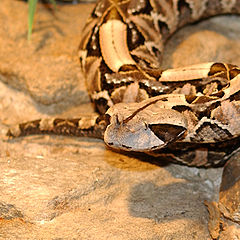Bitisgabonins
As Bitisgabonine constituents are from the snake venom of the widespread in large parts of the rain forests West and South Africa Gabon Viper ( Bitis gabonica hereinafter). Bitisgabonin-1 and Bitisgabonin-2 are known so far, both act as disintegrins and prevent the function of integrins in blood clotting .
Structure and effect
Bitisgabonins are heterodimers , which are built up from a protein ( gabonin -1 or gabonin-2) and the disintegrin domain of the PII metalloprotease -4. Bitisgabonin-1 has a size of 15.183 kDa , bitisgabonin-2 of 15.111 kDa, which are accounted for in approximately equal parts by the respective sub-components of the dimer.
Like the integrins involved in blood coagulation, the bitisgabonins have binding sites for adhesion proteins with the "RGD" recognition feature (Arg-Gly-Asp; RGD sequence ), with the help of which they are able to bind the fibronectin required for coagulation . This is thus taken from the coagulation process, which means that it only takes place incompletely and sticking is not possible. In this way, the bitisgabonins support the hemorrhagic effect of snake venom.
history
The bitisgabonins were first used as heterodimers by Calvete et al. Described and named in 2007. They were discovered during an analysis of the Gaboon viper venom proteome using a number of different analytical methods. Bitisgabonin-1 was shown as peak 11, bitigabonin-2 as peak 14 in an HPLC analysis. The two fractions were then isolated and examined further.
literature
- Juan J. Calvete, Cezary Marcinkiewicz, Libia Sanz: Snake venomics of Bitis gabonica gabonica. Protein family composition, subunit organization of venom toxins, and characterization of dimeric disintegrins bitisgabonin-1 and bitisgabonin-2 . In: Journal of Proteome Research . tape 6 , no. 1 , 2007, p. 326-336 , doi : 10.1021 / pr060494k , PMID 17203976 .
